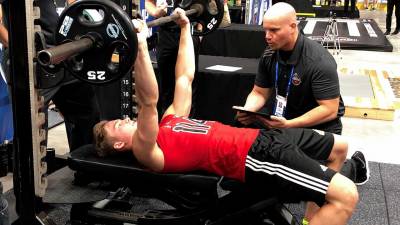It’s that time of year once again. A time when 100+ of the world’s best young hockey players come together to take place in the NHL combine. Testing, interviews, meetings and assessments all strategically designed in order to further streamline managements draft day decision making. The tricky part (aside from evaluating on ice skill and character) is deducing which off-ice tests best transfer into on ice performance.

The purpose of this brief article was to explore the research re: the relationship and predictability of combine testing relative to on ice performance. This review explored 5 research articles.
Off -Ice Performance and Draft Status of Elite Ice Hockey Players [1]
Question: Could tests performed at the combine distinguish draft status? This was a retrospective cross-sectional study design with performance and draft order from 2001-2003.
Findings: No significant effect of off-ice performance on draft selection. No single test could distinguish between draft rounds in the 3 years sampled. “It appears off ice tests cannot accurately predict ice hockey playing ability in an elite group of athletes.” Perhaps other variables such as on-ice skating ability and hockey sense weigh more heavily in the decision-making process for NHL GM’s and coaches.
Positional Performance Profiling of Elite Ice Hockey Players [2]
Question: Is positional profiling for Elite hockey players possible by examining anthropometric and physiological performance? This was a retrospective cross-sectional study design using the same pool of data mentioned above.
Findings: 1) Defenseman were heavier and taller than both forwards and goaltenders. Defensemen performed more reps on the bench press than both forward and goaltenders. 2) Goaltenders showed greater body-fat percentage compared with forwards. Goaltenders had greater flexibility, but lower upper body strength measures (bench press, push-ups) and aerobic capacity compared with at least one other position. No positional differences were discerned from broad jump, vertical jump, aerobic power and curl-ups. The research supports the use of anthropometric measurements, upper body strength, and anaerobic capacity to distinguish among positions in elite level ice hockey.
Relationship of Physical Fitness Test Results and Hockey Playing Potential in Elite-Level Ice Hockey Players [3]
Question: What fitness capacities predict hockey playing potential at the elite level (determined by entry draft order)? Combine results were compared to draft selection order on a total of 853 players.
Findings: Regression models revealed peak anaerobic output to be important for higher draft selection in all positions. Removal of goaltenders from the revealed standing long jump a significant predictor variable for both forwards and defensemen.
The Usefulness and Reliability of Fitness Testing Protocols For Ice Hockey Players: A Literature Review [4]
Findings: “The majority of studies (15) in this review suggest that off-ice testing has limited use when testing ice hockey players.” It is proposed that ice hockey adhere to more specific testing measures both on, and off the ice.
Importance of Body Composition in the National Hockey League Combine Physiological Assessments [5]
Question: To investigate the importance of body composition in the battery of combine physical tests
Findings: All participants underwent combine testing as well as a dual energy x-ray absorptiometry scan to measure boy comp. Partial correlations were used to explore the relationship among body comp and combine testing. In 4 of the 6 strength/power tests (Wingate, long jump, bench press, and both grip strengths), lower and upper lean tissue explained significant amounts of variance.
Key Takeaways:
- Most off-ice tests show weak correlation to on-ice ability.
- My thoughts:Hockey is played on the ice in a near frictionless environment. This environment affects the neuromuscular system and the requisite muscles needed for movement. Running and skating are very different bio-motor abilities. There’s a reason Lance Armstrong finished 868that the 2006 New York City Marathon. His neuromuscular system adapted to the unique demands of cycling, not running, regardless of his VO2max.
- Draft skill and character, off-ice testing comes second
- My thoughts.There doesn’t appear to be near enough evidence to correlate any unique test to on-ice ability as a hockey player. Hockey is a unique game of read and react, anticipation, acceleration, change of direction and resiliency. The best test is the game itself. Scouting plays a critical role in this process.
- Do combine numbers matter?
- My thoughts.I sit on both sides of the fence. On one hand, great numbers may indicate dedication, commitment and work ethic. On the other it may just mean some young men have matured faster than others. Finally, many of these young athletes have zero to minimal training ages in the gym. In this case poor numbers mean nothing more than a higher ceiling in the future.
- Vescovi, J.D., et al., Off-ice performance and draft status of elite ice hockey players.International journal of sports physiology and performance, 2006. 1(3): p. 207-221.
- Vescovi, J.D., T.M. Murray, and J.L. VanHeest, Positional performance profiling of elite ice hockey players.International journal of sports physiology and performance, 2006. 1(2): p. 84-94.
- Burr, J.F., et al., Relationship of physical fitness test results and hockey playing potential in elite-level ice hockey players.The Journal of Strength & Conditioning Research, 2008. 22(5): p. 1535-1543.
- Nightingale, S.C., S. Miller, and A. Turner, The usefulness and reliability of fitness testing protocols for ice hockey players: A literature review.The Journal of Strength & Conditioning Research, 2013. 27(6): p. 1742-1748.
- Chiarlitti, N.A., et al., Importance of Body Composition in the National Hockey League Combine Physiological Assessments.The Journal of Strength & Conditioning Research, 2018. 32(11): p. 3135-3142.